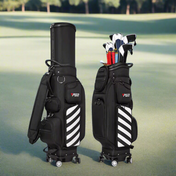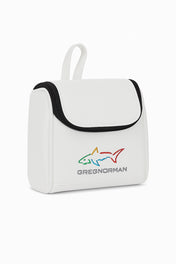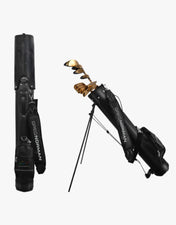Flying out for a weekend round in Dubai, a corporate scramble in Bengaluru, or a monsoon-season trip to Kolkata can be brutal on equipment if a Golf Travel Bag is packed the wrong way. Airlines move fast, bags get stacked, and drops happen.
The good news is that most damage is preventable with the right prep and the best travel golf bag with wheels.
Use this guide to pack like a tour rep and arrive with driver heads, shafts, and putter faces intact.
Common mistake 1: Leaving driver and fairway heads attached
- Adjustable woods are the first to snap when baggage takes a hard fall. Detach the driver and fairway heads, put each into its headcover, and stow them in a protected pocket inside the Golf Travel Bag. Wrap the shafts with a towel or soft layer to prevent scuffing. Take a quick photo of the hosel settings before removal, so rebuilding at the destination is quick and accurate.
Common mistake 2: No “stiff arm” or top brace inside the bag
- The top of the bag takes the hit when bags tumble. Add a telescopic stiff arm or a simple internal brace to absorb impact before it reaches the clubs. In a pinch, a sturdy umbrella works. The goal is to make the brace the highest point, so the blow never lands on a graphite shaft tip.
Common mistake 3: Empty spaces that let clubs rattle
- Air gaps let momentum build and turn irons into hammers. Pack towels, rain gear, or a mid-layer around the clubheads to create a tight bundle. Thread a towel through the top section to bind irons together lightly, then add a second soft layer around the driver and hybrid area. The bundle should feel snug when the bag is closed.
Common mistake 4: Shafts are aligned the wrong way
- Shafts should sit with the most vulnerable points protected low, not exposed high. If the bag has a 14-way top, group longer clubs centrally and shorter clubs around them to create a smooth dome shape. Avoid having one lone shaft stick higher than the rest. For stand bags, secure the legs so they do not deploy in transit.
Common mistake 5: Overloading side pockets
- Stuffing balls, shoes, and accessories into one side creates torsion and stress on zips. Distribute weight evenly, keep heavy items low and central, and avoid overpacking. If checking a suitcase as well, move golf balls there to reduce bag weight and risk. The best travel golf bag with wheels rolls straighter when the weight is balanced.
Common mistake 6: Choosing the wrong case for the trip
- Soft covers are lighter and easier to store, but they need careful internal padding. Hard cases are heavier yet offer maximum crush protection for long-haul or multi-leg flights. A hybrid design with a rigid top and soft base often hits the sweet spot. If travelling often through busy hubs, consider a hard case for peace of mind.
What great packing looks like
- Start by removing wood heads and securing the shafts. Add a stiff arm at full height. Wrap clubheads with a soft layer to form a compact dome. Fill the remaining space with clothing or towels for shock absorption. Lock zips without forcing them and test by gently shaking the bag. Nothing should clatter.
Why wheels matter more than expected
- The best travel golf bag with wheels reduces handling shocks because it stays upright and rolls smoothly across curbs, tiles, and airport joints. Look for wide, in-line skate wheels or protected spinner layouts, reinforced base rails, and a grab handle at both ends. Stable rolling reduces drops and sideloads that can crack graphite.
Fit and size checks before checkout.
- Confirm that the Golf Travel Bag fits the longest driver length with the stiff arm in place. Check internal padding at the top dome and base plate. Seek compression straps inside and outside to clamp the stand or cart bag securely. If buying online, review the exact internal dimensions, not just overall height.
Airport and airline reality checks
Nonstop flights reduce handling risk. Add a bold ID tag plus a secondary card inside the bag. Take timestamped photos before check-in for claim support. Weigh your packed bag to stay within airline limits so ground staff are not forced to repack or squeeze a zip that is already under stress.
India-specific travel tips
During monsoon months, line the base with a light poly layer or pack an extra towel to manage moisture after baggage holds. For early morning domestic legs, expect dew and wet ramps; waterproof covers and hard-shell tops earn their keep in these windows. If connecting through humid hubs, air out the bag on arrival to prevent odours and mildew.
Quick pack checklist
- Remove and cover wood heads
- Install a stiff arm or internal brace
- Fill all air gaps with soft layers
- Balance weight low and central
- Secure legs and straps
- ID tags outside and inside
Conclusion
Most travel damage comes from small oversights that compound in transit. Pack with intent, brace the top, remove wood heads, and build a tight, cushioned dome around the club area. Choose a case that matches the itinerary and lean toward the best travel golf bag with wheels for stability on long airport walks.
Do these basics well, and the Golf Travel Bag becomes a reliable shield, so the first swing at the destination is confident, not cautious.




